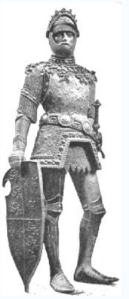
Traduzione by ZAIRA MORVILLO, volontaria di English Gratis.
Il testo originale e l’immagine sono tratti da una pagina del sito inglese
di Wikipedia e sono disponibili nel rispetto della licenza Creative Commons Attribution 2.5 photo credit
King Arthur
Re Artù
King Arthur was a legendary British leader who, according to medieval histories and romances, led the defence of Britain against the Saxon invaders in the early 6th century.
Re Artù fu un leggendario capo britannico che, secondo storie e romanzi cavallereschi medievali, capeggiò la difesa della Gran Bretagna contro gli invasori sassoni agli inizi del VI secolo.
The details of Arthur’s story are mainly composed of folklore and literary invention, and his historical existence is debated and disputed by modern historians.
I particolari della storia di Artù sono fatti principalmente di invenzione letteraria e folklore, e la sua esistenza storica viene discussa e contestata dagli storici moderni.
The sparse historical background of Arthur is gleaned from various histories, including the Annales Cambriae, the Historia Brittonum, and the writings of Gildas.
L’esiguo sfondo storico della vicenda di Artù viene assemblato a partire da varie opere storiche, inclusi gli Annales Cambriae, la Historia Brittonum, e gli scritti di Gildas.
Arthur’s name also occurs in early poetic sources such as Y Gododdin.
Il nome di Artù si rinviene anche in fonti poetiche arcaiche come le Y Gododdin.
>>> The legendary Arthur developed as a figure of international interest largely through the popularity of Geoffrey of Monmouth’s fanciful and imaginative 12th-century Historia Regum Britanniae (History of the Kings of Britain).
Il leggendario personaggio di Artù si sviluppò come figura di interesse internazionale fondamentalmente attraverso la popolarità della fantastica e immaginosa Historia Regum Britanniae (Storia dei regnanti della Gran Bretagna) di Geoffrey di Monmouth nel XII secolo.
However, some Welsh and Breton tales and poems relating the story of Arthur date from earlier than this work; in these works, Arthur appears either as a great warrior defending Britain from human and supernatural enemies or as a magical figure of folklore, sometimes associated with the Welsh Otherworld, Annwn.
Tuttavia, alcuni racconti e poemi gallesi e bretoni che raccontano la storia di Artù risalgono a prima di questo lavoro; in queste opere, Artù appare sia come un grande guerriero che difende la Gran Bretagna da nemici umani e soprannaturali, sia come una figura magica del folklore, talvolta associata con Annwn, l’oltretomba gallese.
How much of Geoffrey’s Historia (completed in 1138) was adapted from such earlier sources, rather than invented by Geoffrey himself, is unknown.
Non si sa quanto della Historia di Geoffrey (completata nel 1138) sia stata adattata da queste precedenti fonti, piuttosto che inventata dallo stesso Geoffrey.
Although the themes, events and characters of the Arthurian legend varied widely from text to text, and there is no one canonical version, Geoffrey’s version of events often served as the starting point for later stories.
Sebbene i temi, gli eventi e i personaggi della leggenda di Artù variassero ampiamente da testo a testo, e non vi fosse alcuna versione canonica, la versione degli eventi di Geoffrey servì spesso come punto di partenza per rielaborazioni successive.
Geoffrey depicted Arthur as a king of Britain who defeated the Saxons and established an empire over Britain, Ireland, Iceland, Norway and Gaul.
Geoffrey descrisse Artù come il re della Gran Bretagna che sconfisse i sassoni e stabilì un impero in Gran Bretagna, Irlanda, Islanda, Norvegia e Gallia.
In fact, many elements and incidents that are now an integral part of the Arthurian story appear in Geoffrey’s Historia, including Arthur’s father Uther Pendragon, the wizard Merlin, the sword Excalibur, Arthur’s birth at Tintagel, his final battle against Mordred at Camlann and final rest in Avalon.
Infatti, molti elementi e avvenimenti che sono ormai parte integrante della storia di Artù appaiono nella Historia di Geoffrey, come ad esempio il padre di Artù Uther Pendragon, il mago Merlino, la spada Excalibur, la nascita di Artù a Tintagel, la battaglia finale contro Mordred a Camlann e il suo luogo di sepoltura ad Avalon.
The 12th-century French writer Chrétien de Troyes, who added Lancelot and the Holy Grail to the story, began the genre of Arthurian romance that became a significant strand of medieval literature.
Lo scrittore francese del XII secolo Chrétien de Troyes, il quale aggiunse Lancillotto e il Santo Graal alla storia, iniziò il genere del romanzo arturiano che diventò un filone significativo della letteratura medievale.
In these French stories, the narrative focus often shifts from King Arthur himself to other characters, such as various Knights of the Round Table.
In queste storie francesi, l’epicentro narrativo spesso si sposta da Re Artù ad altri personaggi, come i vari Cavalieri della Tavola Rotonda.
Arthurian literature thrived during the Middle Ages but waned in the centuries that followed until it experienced a major resurgence in the 19th century.
La letteratura arturiana fiorì durante il Medioevo, ma subì un declino nei secoli seguenti per poi conoscere una importante rinascita nel XIX secolo.
In the 21st century, the legend lives on, both in literature and in adaptations for theatre, film, television, comics and other media.
Nel XXI secolo, la leggenda continua, sia nella letteratura che negli adattamenti per teatro, film, televisione, fumetti e altri media.

